A Compact V-Band Transit Time Oscillator with Reflective Modulation Cavity
Abstract
:1. Introduction
2. Performance of Original RCTTO
3. Design of Reflective Modulation Cavity
3.1. Reflection of TEM Mode
3.2. Modulation of Electron Beam
4. Typical Simulation Results
5. Conclusions
Author Contributions
Funding
Data Availability Statement
Conflicts of Interest
References
- Rostov, V.V.; Totmeninov, E.M.; Tsygankov, R.V.; Kurkan, I.K.; Kovalchuk, O.B.; Elchaninov, A.A.; Stepchenko, A.S.; Gunin, A.V.; Konev, V.Y.; Yushchenko, A.Y.; et al. Two-wave ka-band nanosecond relativistic Cherenkov oscillator. IEEE Trans. Electron. Devices 2018, 65, 3019–3025. [Google Scholar] [CrossRef]
- Zhang, D.; Zhang, J.; Zhong, H.; Jin, Z. Analysis of the mode composition of an X-band overmoded O-type Cerenkov high-power microwave oscillator. Phys. Plasmas 2012, 19, 103102. [Google Scholar] [CrossRef]
- Teng, Y.; Cao, Y.; Song, Z.; Ye, H.; Shi, Y.; Chen, C.; Sun, J. A ka-band TM02 mode relativistic backward wave oscillator with cascaded resonators. Phys. Plasmas 2014, 21, 123108. [Google Scholar] [CrossRef]
- Bai, Z.; Zhang, J.; Zhong, H. A dual-mode operation overmoded coaxial millimeter-wave generator with high power capacity and pure transverse electric and magnetic mode output. Phys. Plasmas 2016, 23, 043109. [Google Scholar] [CrossRef]
- Agafonov, M.A.; Arzhannikov, A.V.; Ginzburg, N.S.; Ivanenko, V.G.; Kalinin, P.V.; Kuznetsov, S.A.; Peskov, N.Y.; Sinitsky, S.L. Generation of hundred joules pulses at 4-mm wavelength by FEM with sheet electron beam. IEEE Trans. Plasma Sci. 1998, 26, 531–535. [Google Scholar] [CrossRef]
- Ye, H.; Chen, C.; Ning, H.; Tan, W.; Teng, Y.; Shi, Y.; Wu, P.; Song, Z.; Cao, Y.; Du, Z. Preliminary research on overmoded high-power millimeter-wave Cerenkov generator with dual-cavity reflector in low guiding magnetic field. Phys. Plasmas 2015, 22, 123110. [Google Scholar] [CrossRef]
- Chen, S.; Zhang, J.; Zhang, J.; Gao, J.; Zhang, P.; Ge, X. Experimental Research of the V-Band High Power Microwave Generation With Coaxial Cerenkov Oscillator. IEEE Electron. Device Lett. 2022, 43, 288–291. [Google Scholar] [CrossRef]
- Chen, S.; Zhang, J.; Zhang, J.; Wang, H. A V-Band Overmoded Coaxial Millimeter-Wave Oscillator Based on a New Method of Asymmetric Modes Suppression. IEEE Trans. Electron. Devices 2020, 67, 2573–2579. [Google Scholar] [CrossRef]
- Yang, F.; Dang, F.; Ge, X.; He, J.; Ju, J.; Zhang, X. A compact coaxial relativistic klystron amplifier with three cascaded single-gap bunching cavities for efficient output. Phys. Plasmas 2022, 29, 093111. [Google Scholar] [CrossRef]
- Zhang, P.; Ge, X.; Dang, F.; Chi, H.; Yang, H.; He, J. Research on sub-microsecond compact L-band relativistic Cherenkov oscillator. IEEE Trans. Electron. Devices 2022, 69, 6352–6357. [Google Scholar] [CrossRef]
- Lyu, Z.; Luo, H.; Wang, X.; Jiang, S.; Jin, D.; Gong, Y.; Chen, M.; Duan, Z. Compact reversed Cherenkov radiation oscillator with high efficiency. Appl. Phys. Lett. 2022, 120, 053501. [Google Scholar] [CrossRef]
- Zhang, W.; Ju, J.; Zhang, J.; Zhou, Y.; Zhong, H. Theoretical research on TEM mode feedback for compact design of an X-band triaxial klystron amplifier. Phys. Plasmas 2019, 26, 053102. [Google Scholar]
- Deng, B.; He, J.; Ling, J.; Song, L.; Wang, L. Preliminary research of a V-band coaxial relativistic transit-time oscillator with traveling wave output structure. Phys. Plasmas 2021, 28, 103103. [Google Scholar] [CrossRef]
- Miller, R.B. An Introduction to the Physics of Intense Charged Particle Beams; Springer: Berlin/Heidelberg, Germany, 1984; pp. 306–308. [Google Scholar]
- Zhou, J.; Liu, D.; Liao, C.; Li, Z. CHIPIC: An Efficient Code for Electromagnetic PIC Modeling and Simulation. IEEE Trans. Plasma Sci. 2009, 37, 2002–2011. [Google Scholar] [CrossRef]
- Livreri, P. Design of a High-Efficiency Ka-Band TWT Power Amplifier for Radar Applications. IEEE Trans. Plasma Sci. 2022, 50, 2824–2829. [Google Scholar] [CrossRef]
- Iihara, T.; Ito, Y.; Fukuoka, K.; Suehiro, K.; Maki, K. Enhancing the Properties of Oxygen-Free Copper for High-Current Applications through Trace Element Additions. Mater. Trans. 2024, 65, 434–439. [Google Scholar] [CrossRef]
- de Jong, M.S.; Adams, F.P.; Hutcheon, R. Computation of RF Fields for Applicator Design. J. Microw. Power Electromagn. Energy 1992, 27, 136. [Google Scholar] [CrossRef]
- Vlasov, A.N.; Shkvarunets, A.G.; Rodgers, J.C.; Carmel, Y.; Antonsen, T.M.; Abuelfadl, T.M.; Lingze, D.; Cherepenin, V.A.; Nusinovich, G.S.; Botton, M.; et al. Overmoded GW-class surface-wave microwave oscillator. IEEE Trans. Plasma Sci. 2000, 28, 550–560. [Google Scholar]
- Xiao, R.; Chen, K.; Shi, Y.; Chen, C. Toward 80% Efficiency in a Super Klystron-Like Relativistic Backward Wave Oscillator with Second and Third Harmonic Coaxial-Premodulation Cavity. IEEE Trans. Electron. Devices 2023, 70, 2521–2525. [Google Scholar] [CrossRef]
- Lemke, R.W.; Clark, M.C.; Marder, B.M. Theoretical and experimental investigation of a method for increasing the output power of a microwave tube based on the split-cavity oscillator. J. Appl. Phys. 1994, 75, 5423–5432. [Google Scholar] [CrossRef]
- Xiao, R.; Chen, C.; Wu, P.; Song, Z.; Sun, J. Role of dc space charge field in the optimization of microwave conversion efficiency from a modulated intense relativistic electron beam. J. Appl. Phys. 2013, 114, 214503. [Google Scholar] [CrossRef]
- Xiao, R.; Chen, K.; Wang, H.; Wang, D.; Shi, Y.; Gao, L. Theoretical calculation and particle-in-cell simulation of a multi-mode relativistic backward wave oscillator operating at low magnetic field. Phys. Plasmas 2022, 29, 043103. [Google Scholar] [CrossRef]

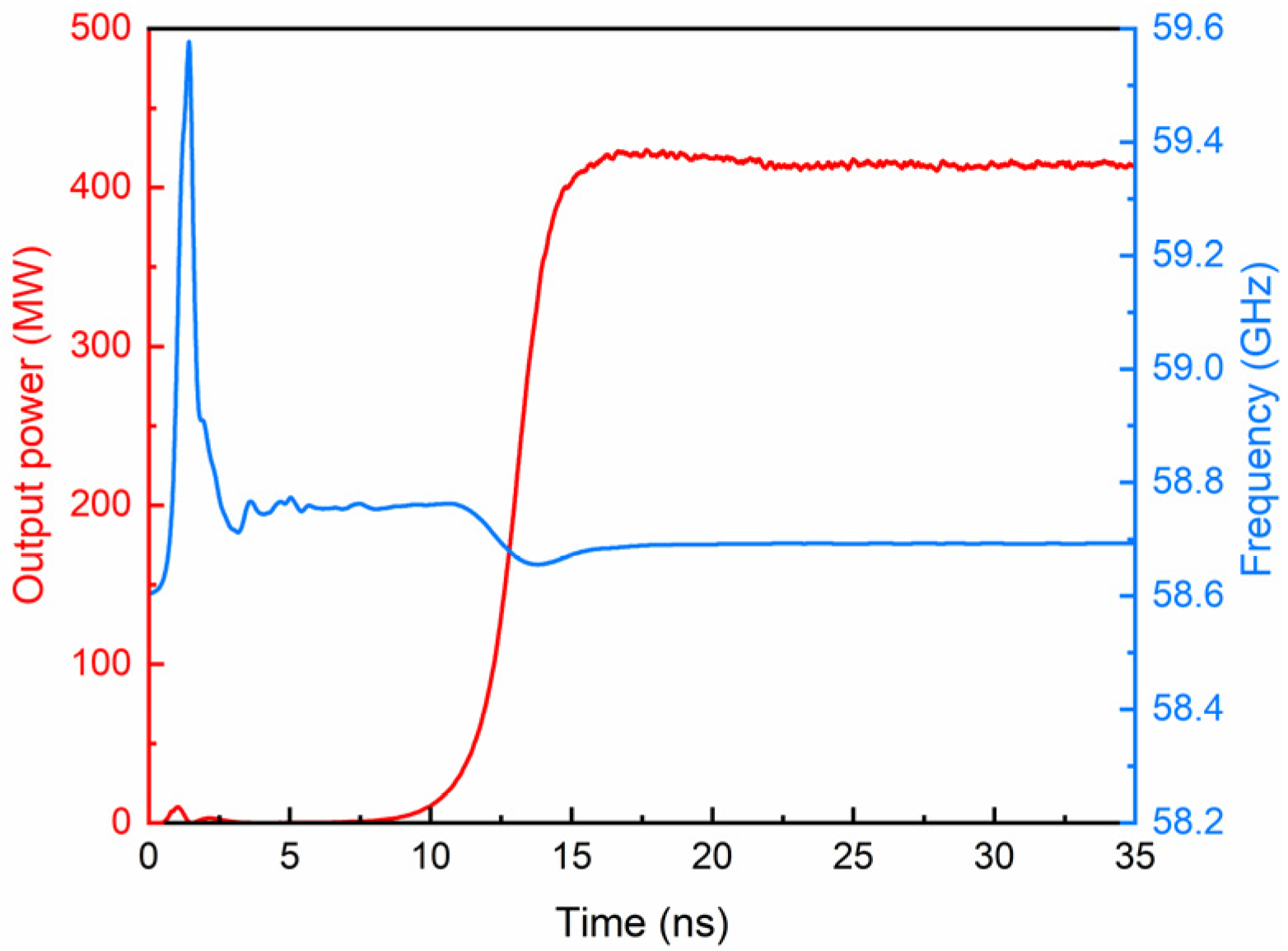
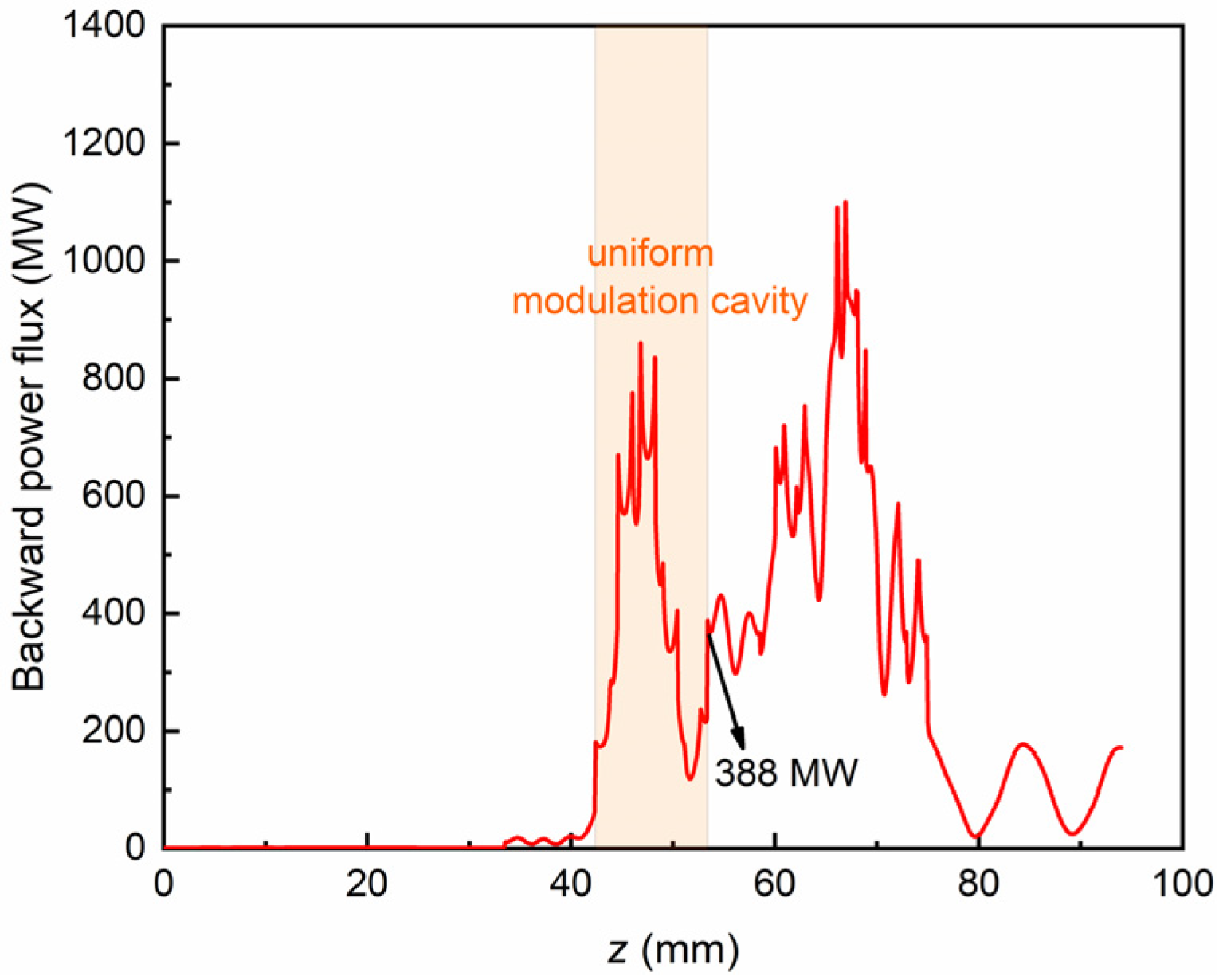

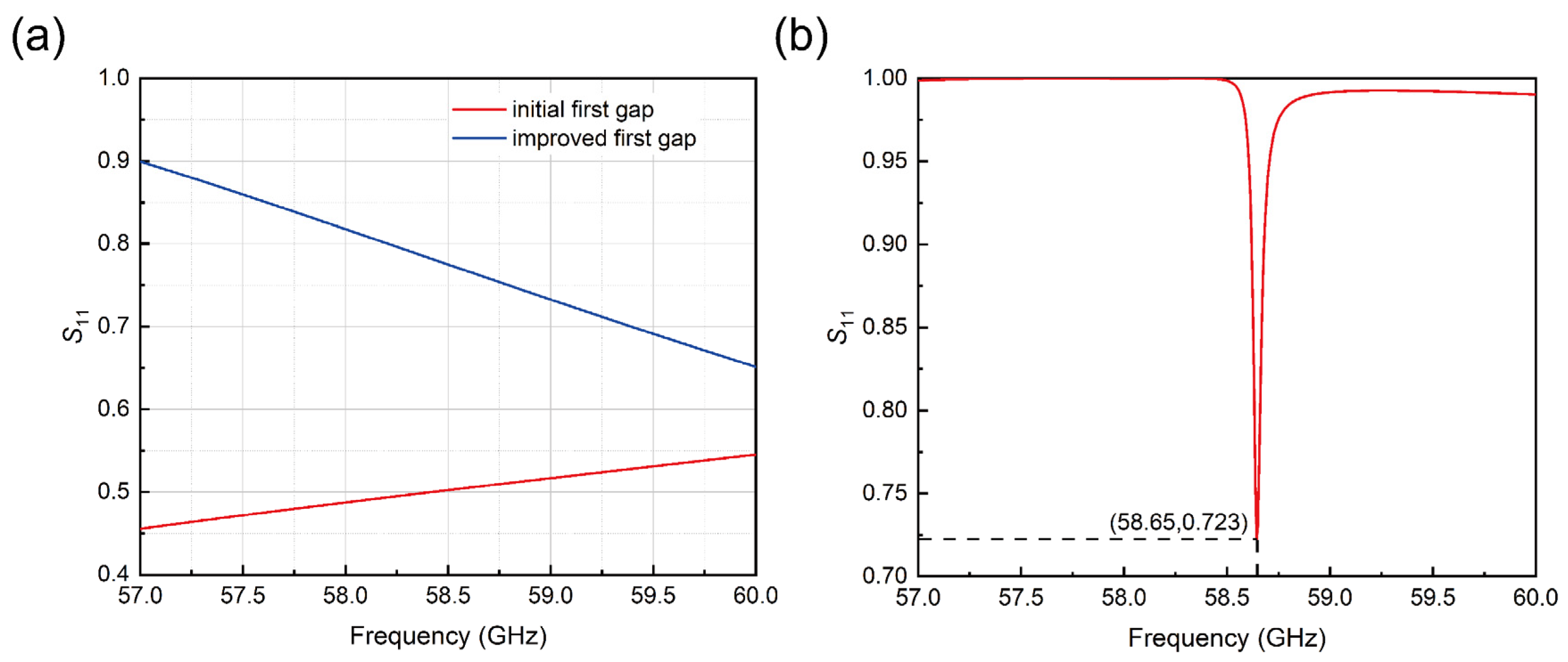

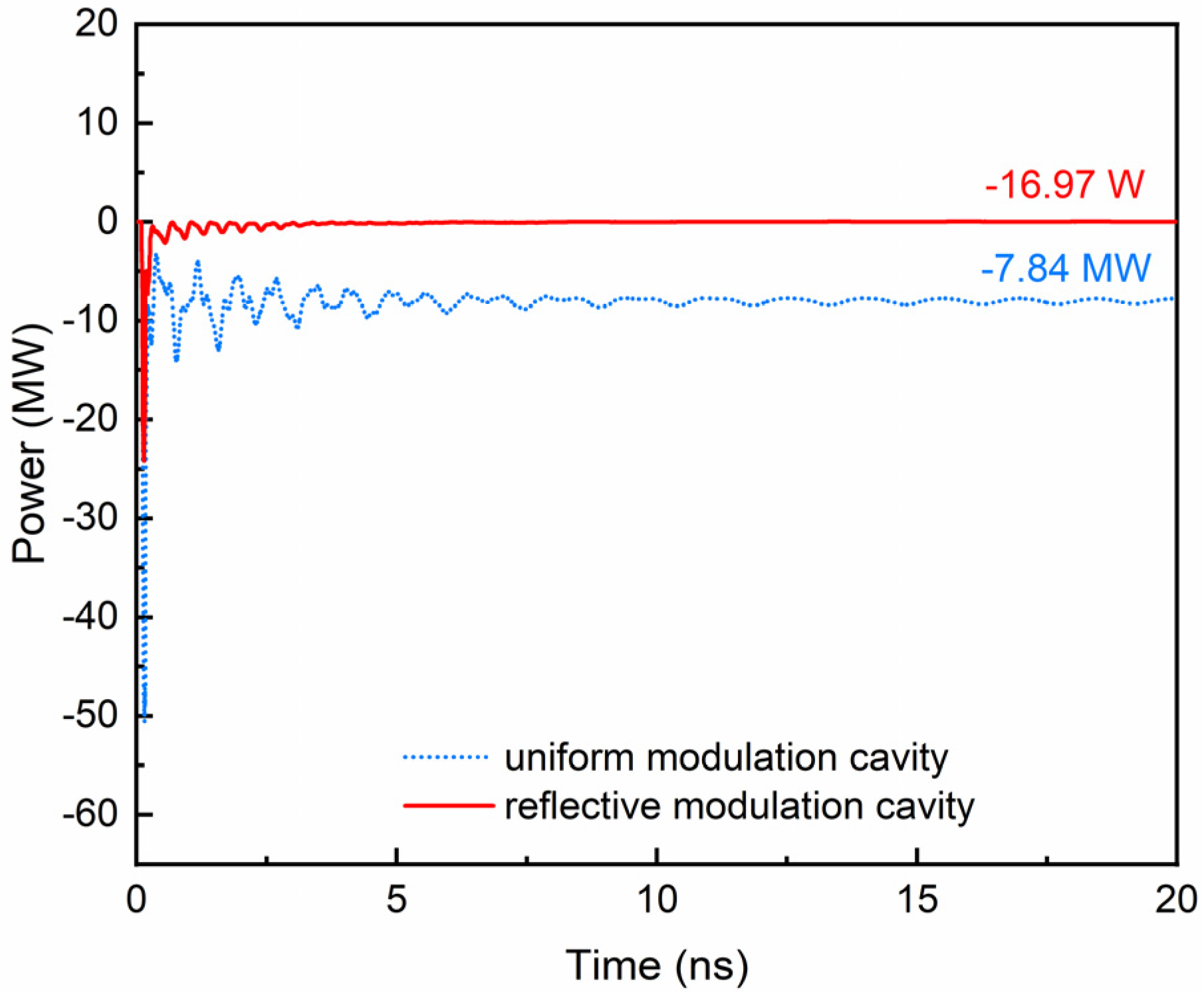
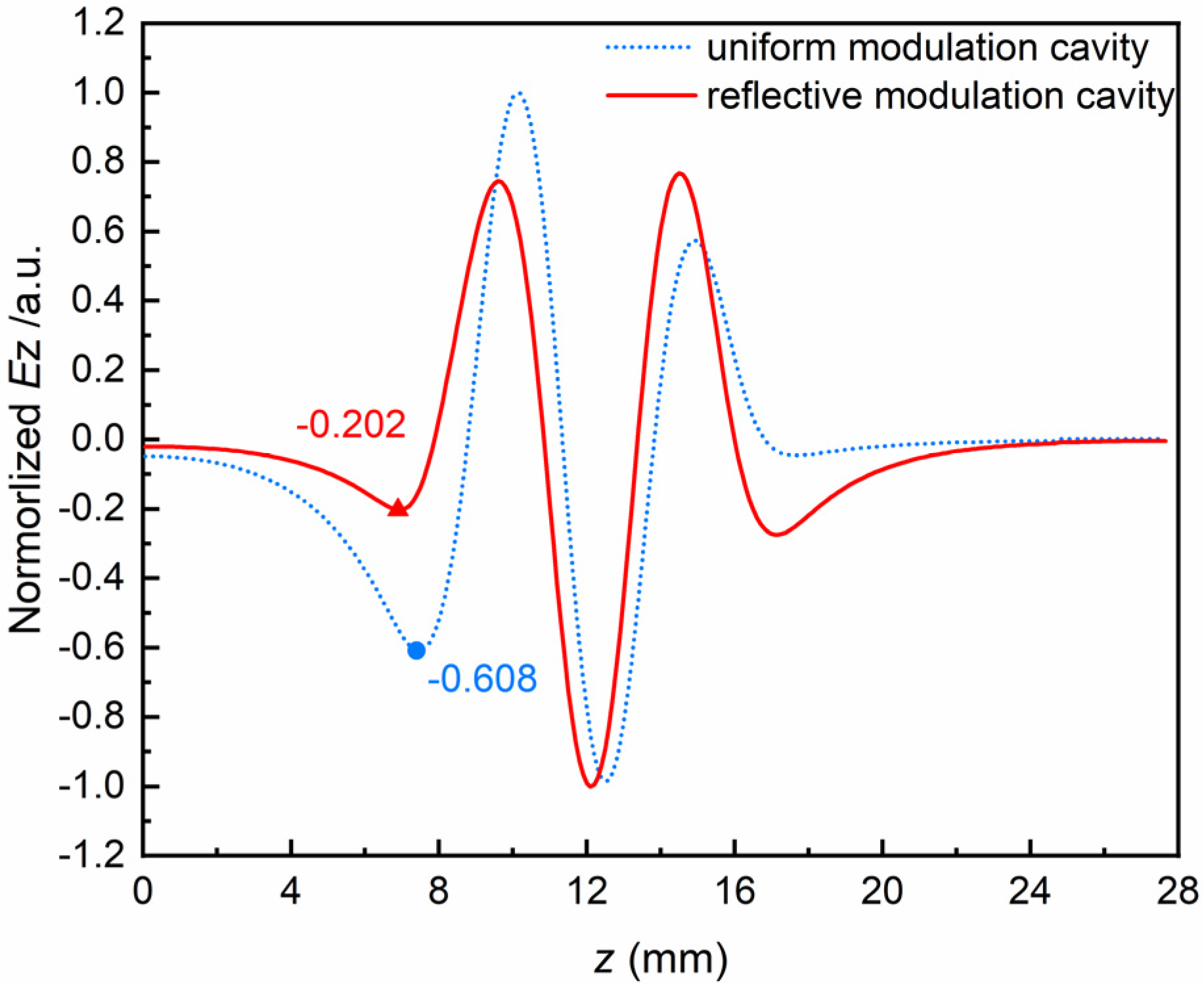

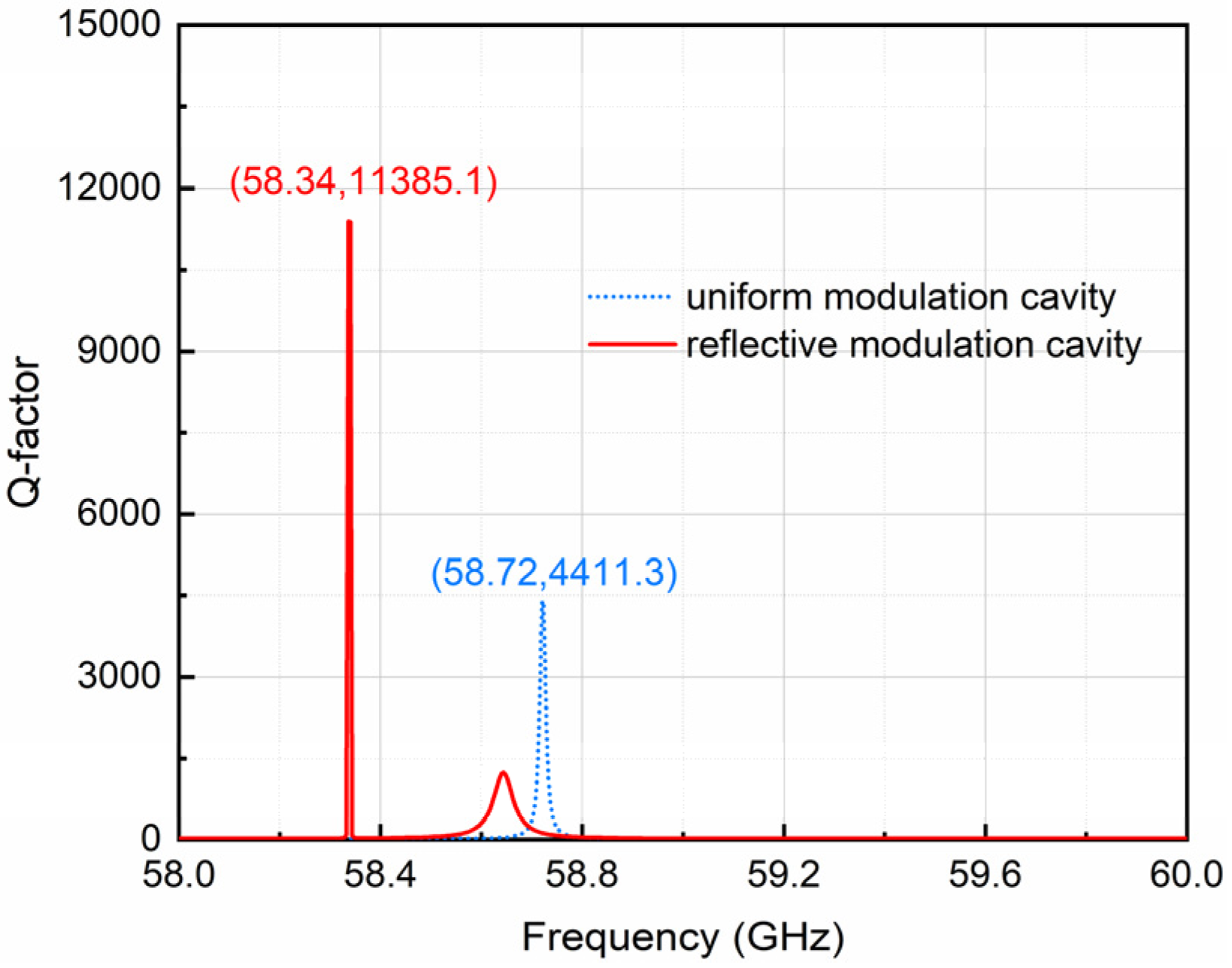



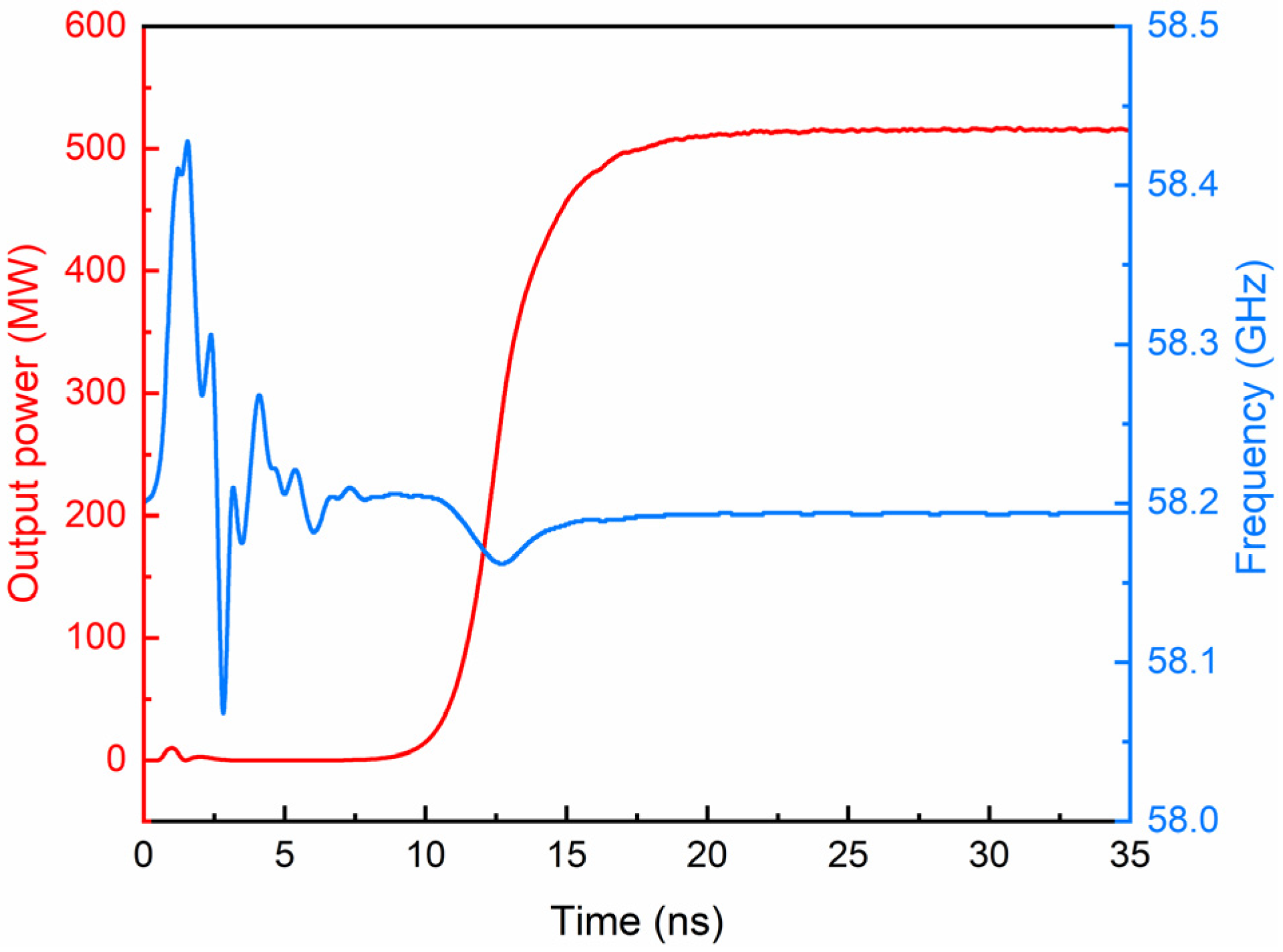


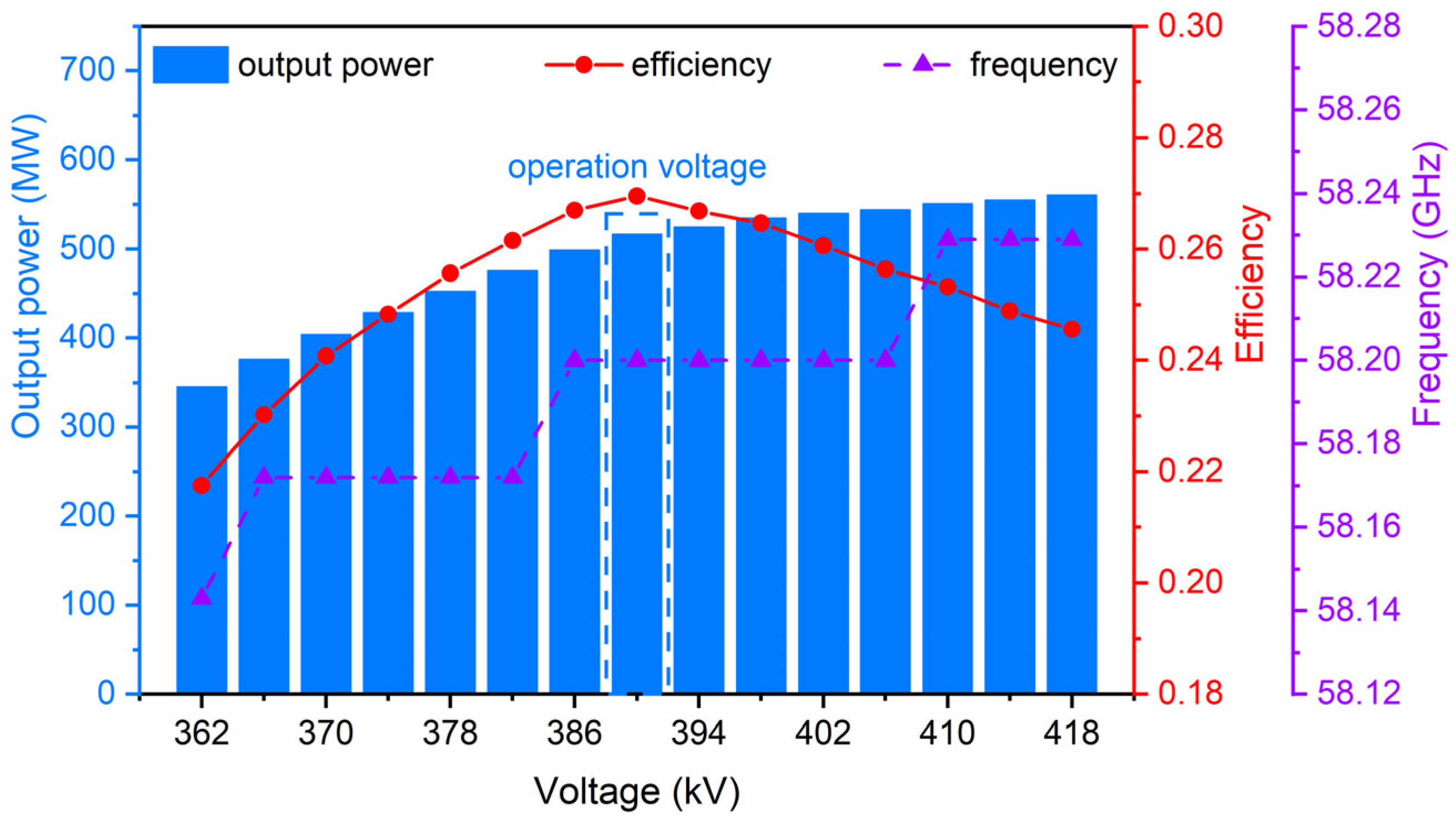
Disclaimer/Publisher’s Note: The statements, opinions and data contained in all publications are solely those of the individual author(s) and contributor(s) and not of MDPI and/or the editor(s). MDPI and/or the editor(s) disclaim responsibility for any injury to people or property resulting from any ideas, methods, instructions or products referred to in the content. |
© 2024 by the authors. Licensee MDPI, Basel, Switzerland. This article is an open access article distributed under the terms and conditions of the Creative Commons Attribution (CC BY) license (https://creativecommons.org/licenses/by/4.0/).
Share and Cite
Chen, Z.; Wang, L.; Ling, J.; Song, L.; He, J.; Yao, J.; Xu, W. A Compact V-Band Transit Time Oscillator with Reflective Modulation Cavity. Electronics 2024, 13, 3290. https://doi.org/10.3390/electronics13163290
Chen Z, Wang L, Ling J, Song L, He J, Yao J, Xu W. A Compact V-Band Transit Time Oscillator with Reflective Modulation Cavity. Electronics. 2024; 13(16):3290. https://doi.org/10.3390/electronics13163290
Chicago/Turabian StyleChen, Zulong, Lei Wang, Junpu Ling, Lili Song, Juntao He, Jinmei Yao, and Weili Xu. 2024. "A Compact V-Band Transit Time Oscillator with Reflective Modulation Cavity" Electronics 13, no. 16: 3290. https://doi.org/10.3390/electronics13163290




